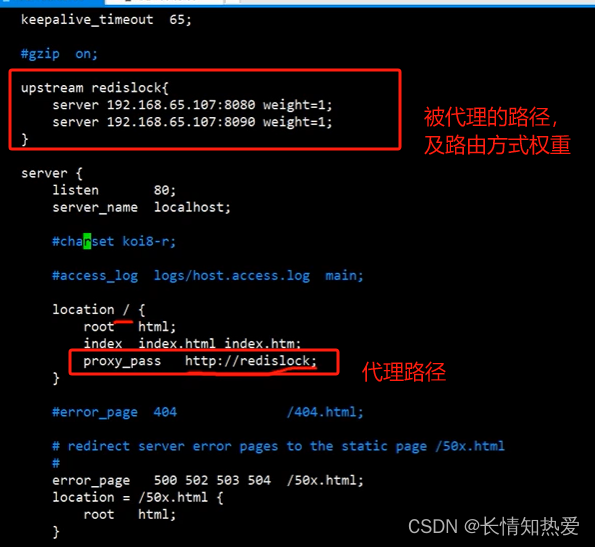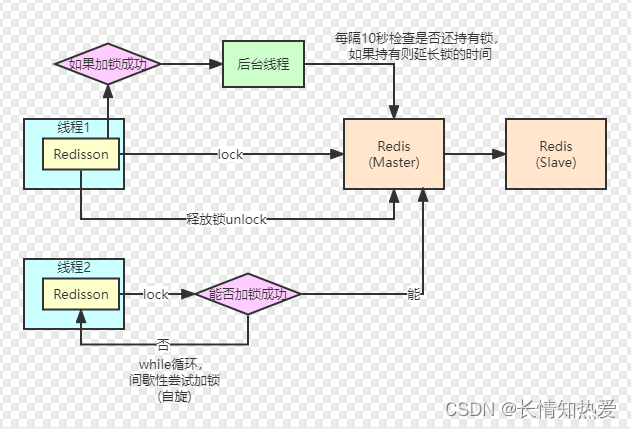集群分布式场景高并发
1.negix配置代理和路由

高并发场景超卖问题
1.使用原生redis控制超卖时(若是商品,则可以将商品id作为锁对象),会遇到的问题
问题一:若直接使用:将获取锁的对象和设置的超时的时间分开,则不能控制原子性,如下所示
Boolean result = stringRedisTemplate.opsForValue().setIfAbsent(lockKey, "zhuge");
stringRedisTemplate.expire(lockKey, 10, TimeUnit.SECONDS);
问题二:若直接使用:将获取锁的对象和设置的超时的时间放在一个原子操作里执行时,在临界条件下,当程序执行到最后准备释放锁时候,锁的超时时间已到,则此时的锁成为已过期,则释放不了锁;而当下一个线程也来执行任务时,前一个任务将这个任务所拿的所给释放掉了(释放掉不属于自己的锁对象);则引入redisson分布式锁来解决当前的问题,redisson具有锁续命机制
@RestController
public class IndexController {@Autowiredprivate Redisson redisson;@Autowiredprivate StringRedisTemplate stringRedisTemplate;@Autowiredprivate RedisTemplate redisTemplate;@RequestMapping("/deduct_stock")public String deductStock() {String lockKey = "lock:product_101";//Boolean result = stringRedisTemplate.opsForValue().setIfAbsent(lockKey, "zhuge");//stringRedisTemplate.expire(lockKey, 10, TimeUnit.SECONDS);String clientId = UUID.randomUUID().toString();Boolean result = stringRedisTemplate.opsForValue().setIfAbsent(lockKey, clientId, 30, TimeUnit.SECONDS); //jedis.setnx(k,v)if (!result) {return "error_code";}try {int stock = Integer.parseInt(stringRedisTemplate.opsForValue().get("stock")); // jedis.get("stock")if (stock > 0) {int realStock = stock - 1;stringRedisTemplate.opsForValue().set("stock", realStock + ""); // jedis.set(key,value)System.out.println("扣减成功,剩余库存:" + realStock);} else {System.out.println("扣减失败,库存不足");}} finally {if (clientId.equals(stringRedisTemplate.opsForValue().get(lockKey))) {stringRedisTemplate.delete(lockKey);}}return "end";}使用分布式锁redisson
redisson使用
引入对应的redission的jar包
<dependency><groupId>org.redisson</groupId><artifactId>redisson</artifactId><version>3.6.5</version></dependency>
设置redission配置
@SpringBootApplication
public class Application {public static void main(String[] args) {SpringApplication.run(Application.class, args);}@Beanpublic Redisson redisson() {// 此为单机模式Config config = new Config();config.useSingleServer().setAddress("redis://localhost:6379").setDatabase(0);return (Redisson) Redisson.create(config);}}redission的基本使用
@RestController
public class IndexController {@Autowiredprivate Redisson redisson;@Autowiredprivate StringRedisTemplate stringRedisTemplate;@Autowiredprivate RedisTemplate redisTemplate;@RequestMapping("/deduct_stock")public String deductStock() {String lockKey = "lock:product_101";//Boolean result = stringRedisTemplate.opsForValue().setIfAbsent(lockKey, "zhuge");//stringRedisTemplate.expire(lockKey, 10, TimeUnit.SECONDS);/*String clientId = UUID.randomUUID().toString();Boolean result = stringRedisTemplate.opsForValue().setIfAbsent(lockKey, clientId, 30, TimeUnit.SECONDS); //jedis.setnx(k,v)if (!result) {return "error_code";}*///获取锁对象RLock redissonLock = redisson.getLock(lockKey);//加分布式锁redissonLock.lock(); // .setIfAbsent(lockKey, clientId, 30, TimeUnit.SECONDS);try {int stock = Integer.parseInt(stringRedisTemplate.opsForValue().get("stock")); // jedis.get("stock")if (stock > 0) {int realStock = stock - 1;stringRedisTemplate.opsForValue().set("stock", realStock + ""); // jedis.set(key,value)System.out.println("扣减成功,剩余库存:" + realStock);} else {System.out.println("扣减失败,库存不足");}} finally {/*if (clientId.equals(stringRedisTemplate.opsForValue().get(lockKey))) {stringRedisTemplate.delete(lockKey);}*///解锁redissonLock.unlock();}return "end";}Redission执行的逻辑流程

Redission分布式锁加锁源码分析
redissonLock.lock(); 加锁
@Overridepublic void lockInterruptibly() throws InterruptedException {lockInterruptibly(-1, null);}执行 lockInterruptibly加锁逻辑
@Overridepublic void lockInterruptibly(long leaseTime, TimeUnit unit) throws InterruptedException {long threadId = Thread.currentThread().getId();Long ttl = tryAcquire(leaseTime, unit, threadId); //尝试去加锁,返回的时加锁后的过期时间// lock acquiredif (ttl == null) { //若ttl为null ,则表示加锁成功 ;若ttl不为null ,则往下走return;}RFuture<RedissonLockEntry> future = subscribe(threadId); //发布订阅,订阅前者执行的任务若提前执行完,则唤醒机制,去重新获取锁commandExecutor.syncSubscription(future);try {while (true) { //进入循环ttl = tryAcquire(leaseTime, unit, threadId); //再次尝试获取锁,返回加锁成功后的过期时间// lock acquiredif (ttl == null) { //若ttl为null ,则表示加锁成功 ;若ttl不为null ,则往下走break;}// waiting for messageif (ttl >= 0) { 若ttl大于ogetEntry(threadId).getLatch().tryAcquire(ttl, TimeUnit.MILLISECONDS);
//进行间歇性锁自旋逻辑,不占用cpu资源} else {getEntry(threadId).getLatch().acquire();}}} finally {unsubscribe(future, threadId);}
// get(lockAsync(leaseTime, unit));}执行tryAcquire(leaseTime, unit, threadId)尝试加锁逻辑
private <T> RFuture<Long> tryAcquireAsync(long leaseTime, TimeUnit unit, final long threadId) {if (leaseTime != -1) {return tryLockInnerAsync(leaseTime, unit, threadId, RedisCommands.EVAL_LONG);}
//leaseTime 默认设置为-1RFuture<Long> ttlRemainingFuture = tryLockInnerAsync(commandExecutor.getConnectionManager().getCfg().getLockWatchdogTimeout(), TimeUnit.MILLISECONDS, threadId, RedisCommands.EVAL_LONG);
//执行加锁逻辑ttlRemainingFuture.addListener(new FutureListener<Long>() { //异步执行,锁续命逻辑@Overridepublic void operationComplete(Future<Long> future) throws Exception {if (!future.isSuccess()) { //若加锁不成功,则退出return;}Long ttlRemaining = future.getNow(); //若加锁成功,则ttlRemaining 为null// lock acquiredif (ttlRemaining == null) {scheduleExpirationRenewal(threadId); //加锁成功,则执行锁续命逻辑}}});return ttlRemainingFuture;}执行tryLockInnerAsync(commandExecutor.getConnectionManager().getCfg().getLockWatchdogTimeout(), TimeUnit.MILLISECONDS, threadId, RedisCommands.EVAL_LONG); 加锁逻辑
<T> RFuture<T> tryLockInnerAsync(long leaseTime, TimeUnit unit, long threadId, RedisStrictCommand<T> command) {
//通过lua脚本来执行加锁逻辑,来保证原子性internalLockLeaseTime = unit.toMillis(leaseTime);return commandExecutor.evalWriteAsync(getName(), LongCodec.INSTANCE, command,//执行加锁逻辑 (key,argv与下面所传参数一一对应)"if (redis.call('exists', KEYS[1]) == 0) then " + //KEY[1]表示下面的getName(),"redis.call('hset', KEYS[1], ARGV[2], 1); " + //ARGV[2]表示下面的getLockName(threadId)"redis.call('pexpire', KEYS[1], ARGV[1]); " + //ARGV[1]表示下面的internalLockLeaseTime"return nil; " +"end; " +
//执行锁重入逻辑(一个线程对同一个锁对象进行多次加锁,此为重入锁逻辑)"if (redis.call('hexists', KEYS[1], ARGV[2]) == 1) then " +"redis.call('hincrby', KEYS[1], ARGV[2], 1); " +"redis.call('pexpire', KEYS[1], ARGV[1]); " +"return nil; " +"end; " +"return redis.call('pttl', KEYS[1]);", //设置返回过期时间Collections.<Object>singletonList(getName()), internalLockLeaseTime, getLockName(threadId));}执行scheduleExpirationRenewal(threadId);锁续命逻辑
private void scheduleExpirationRenewal(final long threadId) {if (expirationRenewalMap.containsKey(getEntryName())) {return;}Timeout task = commandExecutor.getConnectionManager().newTimeout(new TimerTask() {@Overridepublic void run(Timeout timeout) throws Exception {//执行锁续命逻辑RFuture<Boolean> future = commandExecutor.evalWriteAsync(getName(), LongCodec.INSTANCE, RedisCommands.EVAL_BOOLEAN,
//KEYS[1]表示getName(),ARGV[2]表示锁对象getLockName(threadId), ARGV[1]表示过期时间
//判断当前锁的对象,为当前的线程对象,那么则当前的锁的对象设置原始的过期时间,以达到续命效果"if (redis.call('hexists', KEYS[1], ARGV[2]) == 1) then " +"redis.call('pexpire', KEYS[1], ARGV[1]); " +"return 1; " +"end; " +"return 0;",Collections.<Object>singletonList(getName()), internalLockLeaseTime, getLockName(threadId));//异步监听执行 future.addListener(new FutureListener<Boolean>() {@Overridepublic void operationComplete(Future<Boolean> future) throws Exception {expirationRenewalMap.remove(getEntryName());if (!future.isSuccess()) {log.error("Can't update lock " + getName() + " expiration", future.cause());return;}//判断是否任然持有锁,是的话,则getNow()为nullif (future.getNow()) {// reschedule itselfscheduleExpirationRenewal(threadId);//再次执行续命逻辑}}});}}, internalLockLeaseTime / 3, TimeUnit.MILLISECONDS);if (expirationRenewalMap.putIfAbsent(getEntryName(), task) != null) {task.cancel();}}在外层未获取到锁的线程 getEntry(threadId).getLatch().tryAcquire(ttl, TimeUnit.MILLISECONDS);间隙自旋获取锁对象
getLatch()表示信号量,信号量为1,则表示阻塞状态,最终通过发布订阅方式来唤醒当前被阻塞的线程,唤醒后则执行获取锁的逻辑 doAcquireSharedNanos(arg, nanosTimeout);









)
![[DFS深度优先搜索]集合里的乘法](http://pic.xiahunao.cn/[DFS深度优先搜索]集合里的乘法)




任务空间管理)



